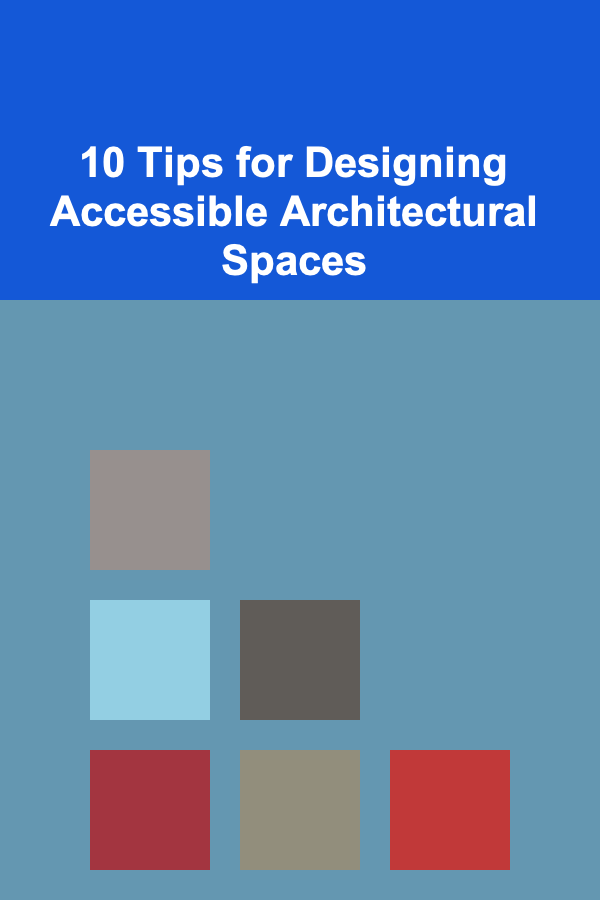
10 Tips for Designing Accessible Architectural Spaces
ebook include PDF & Audio bundle (Micro Guide)
$12.99$8.99
Limited Time Offer! Order within the next:

Designing accessible architectural spaces is more than a legal requirement or a matter of compliance---it's a moral and practical responsibility. Accessibility means creating environments that are welcoming, functional, and usable for people of all abilities. As awareness of the importance of inclusive design grows, so does the need to integrate accessibility into every aspect of architecture, from public buildings to residential homes.
In this article, we'll delve into 10 essential tips for designing architectural spaces that prioritize accessibility, ensuring that people with disabilities can navigate, engage, and participate in these spaces with ease.
Prioritize Universal Design Principles
Universal design is the foundation for creating accessible spaces. This concept emphasizes designing for the broadest possible range of users, regardless of their age, size, ability, or disability. A well-designed space should cater to everyone and provide comfort, usability, and independence.
Key Principles of Universal Design:
- Equitable Use: Ensure that the design is useful and accessible to people with diverse abilities.
- Flexibility in Use: Provide a variety of options for interaction, such as adjustable lighting and adaptable furniture.
- Simple and Intuitive Use: Avoid complexity. Spaces should be easy to understand and navigate for everyone.
- Perceptible Information: Ensure that information is communicated effectively, regardless of sensory abilities.
Universal design doesn't just meet legal requirements; it enriches the experience for all users. This can include adjusting aspects like the height of counters, the width of doors, or the layout of hallways.
Design Wide and Accessible Entrances
Entrances to buildings play a crucial role in the accessibility of a space. Traditional doors, especially heavy ones or those with steps, can be a significant barrier for people with mobility impairments. A well-designed entrance should accommodate various needs, including those of wheelchair users, parents with strollers, and elderly individuals.
Tips for Accessible Entrances:
- Automatic Doors: Install automatic doors or ensure that doors can be easily opened with minimal force.
- Level or Ramp Access: Provide ramps and level access for wheelchair users, avoiding stairs when possible.
- Clear Signage: Use clear and easy-to-read signage to direct individuals to accessible entrances.
The goal is to create a welcoming environment where everyone can enter with ease and dignity.
Incorporate Adequate Circulation Space
Once inside a building, circulation space (the space through which people move) should be designed to allow easy navigation for all users. Adequate circulation space means not only considering physical mobility but also other disabilities such as visual or auditory impairments.
Considerations for Circulation Space:
- Wide Hallways: Ensure hallways and aisles are wide enough to accommodate wheelchairs, walkers, and other mobility aids.
- Clear Pathways: Avoid clutter and ensure that paths are well-lit and free from obstacles.
- Turning Space: Provide sufficient room for people in wheelchairs or with other assistive devices to turn around easily.
Designing ample circulation space makes it easier for all users to navigate without feeling constrained, which helps create a more inclusive environment.
Design Accessible Restrooms
Accessible restrooms are an essential aspect of any public or private building. A well-designed restroom can offer both privacy and dignity to people with disabilities.
Key Features of Accessible Restrooms:
- Wheelchair Accessible Stalls: Ensure that at least one stall is wide enough for wheelchair users to enter, turn, and use comfortably.
- Grab Bars: Install sturdy grab bars near toilets, sinks, and other areas where assistance might be needed.
- Proper Sink Height: Set sinks at an appropriate height so that they are accessible to individuals who may be sitting in a wheelchair.
- Clear Signage: Use universally recognizable symbols and braille to direct users to accessible facilities.
By focusing on these elements, you can provide accessible restrooms that cater to people with varying abilities, improving their overall experience within the space.
Focus on Clear and Legible Signage
For people with visual, auditory, or cognitive impairments, clear signage is crucial in ensuring that individuals can navigate a space independently. Signage should not only indicate directions but also be designed in a way that is universally readable.
Effective Signage Features:
- Large Fonts and High Contrast: Use large fonts with high contrast (e.g., black text on white background) to improve readability.
- Braille: Include braille on signs to help visually impaired individuals read the information.
- Visual and Tactile Symbols: Include symbols and tactile elements that can be understood by people with different disabilities.
- Simple Language: Use clear, simple language on signs to accommodate people with cognitive disabilities.
Accessible signage ensures that all visitors can find their way around easily, without relying on assistance from others.
Implement Visual and Acoustic Design Considerations
Incorporating elements that address both visual and auditory needs can drastically improve the accessibility of a space. Many people rely on both their vision and hearing to navigate the world, and accommodations should be made for those with sensory impairments.
Visual Design Considerations:
- Good Lighting: Provide bright, even lighting in all areas, especially hallways and stairways.
- Contrast and Texture: Use contrasting colors and textures to help visually impaired individuals identify objects and surfaces.
Acoustic Design Considerations:
- Acoustic Panels: Install acoustic panels or noise-reducing materials in areas where sound could interfere with communication.
- Sound Alerts: Provide auditory signals (such as beeps or chimes) at intersections, elevators, and other key locations to assist people with visual impairments.
By integrating both visual and auditory design principles, you create an environment that's truly inclusive for people with varying sensory needs.
Ensure Barrier-Free Movement with Elevators and Lifts
For multistory buildings, elevators and lifts are essential for providing equitable access. People with mobility impairments may not be able to use stairs, so elevators should be designed to accommodate individuals in wheelchairs or with other mobility devices.
Elevator Design Best Practices:
- Clear Buttons: Ensure that elevator buttons are easily accessible and labeled with tactile markings or braille.
- Spacious Interiors: The elevator should be large enough to accommodate a wheelchair and a caregiver if necessary.
- Auditory Signals: Provide auditory cues to announce floors, making the elevator accessible to people with visual impairments.
- Accessible Controls: Place elevator controls at a height that can be reached by people in wheelchairs, ensuring easy operation for all users.
Elevators and lifts are key elements in ensuring the free movement of people, and they must be carefully designed to meet accessibility standards.
Incorporate Flexible and Adaptive Furniture
Furniture plays a significant role in how people interact with a space. When designing for accessibility, it's essential to incorporate adaptable furniture that can cater to the needs of a diverse population.
Features of Adaptive Furniture:
- Adjustable Heights: Use furniture that can be adjusted for people who use wheelchairs, those with varying physical needs, or people with children.
- Clearance: Ensure that there is adequate clearance under tables and counters for people in wheelchairs.
- Non-slip Surfaces: Ensure that furniture has non-slip surfaces, making it safer for individuals with mobility impairments.
Adaptive furniture helps create spaces that people can use comfortably, regardless of their specific needs.
Create Outdoor Spaces That Are Accessible
Outdoor spaces, such as parks, gardens, and courtyards, should also be designed with accessibility in mind. The same principles that apply to interior spaces---such as wide pathways, ramps, and clear signage---are equally important for outdoor environments.
Outdoor Accessibility Features:
- Smooth Pathways: Ensure that walkways are smooth, level, and wide enough to accommodate wheelchairs and strollers.
- Rest Areas: Provide benches or resting spots along pathways for people who may need to take breaks.
- Accessible Parking: Ensure that parking areas have designated spots for people with disabilities, close to the entrance of outdoor spaces.
Designing accessible outdoor spaces creates an environment where everyone can enjoy nature and public areas without barriers.
Stay Updated with Accessibility Guidelines and Laws
Finally, staying informed about the latest accessibility standards and regulations is essential. Guidelines such as the Americans with Disabilities Act (ADA) in the U.S., or other local accessibility laws, provide specific requirements for building design.
How to Stay Updated:
- Consult Local Regulations: Regularly review national and local regulations regarding accessibility.
- Work with Accessibility Experts: Collaborate with accessibility consultants or specialists to ensure that designs meet all necessary standards.
- Ongoing Training: Participate in workshops, seminars, and courses focused on inclusive design to keep your knowledge current.
Remaining up-to-date ensures that your designs are legally compliant and, more importantly, accessible to all users.
Conclusion
Designing accessible architectural spaces requires more than just meeting legal requirements---it requires a commitment to creating environments that are truly inclusive. By incorporating universal design principles, ensuring ample circulation space, focusing on accessibility features like entrances, restrooms, signage, and more, architects can create spaces where everyone feels welcome and valued.
The effort to create accessible environments not only benefits individuals with disabilities but enriches the experience for all users. A well-designed, accessible space fosters independence, dignity, and a sense of belonging for all individuals, regardless of their abilities.
Reading More From Our Other Websites
- [Personal Financial Planning 101] How to Plan for Your Child's College Fund
- [Personal Care Tips 101] How to Use Nail Polish Remover to Achieve a Clean, Professional Manicure at Home
- [Simple Life Tip 101] Best Zero‑Waste Bathroom Swaps for Busy Professionals
- [Organization Tip 101] How to Set Up a Meal Prep Station in Your Kitchen
- [Organization Tip 101] How to Maintain an Inventory of Volunteer Supplies
- [Home Cleaning 101] How to Tackle a Deep Cleaning Project in Your Home
- [Polymer Clay Modeling Tip 101] Mastering Polymer Clay: The Ideal Baking Temperatures for Perfect Creations
- [Horseback Riding Tip 101] From Beginners to Trailblazers: Planning the Perfect Duo Horse-Riding Day
- [Personal Care Tips 101] How to Make Exfoliating Scrubs from Everyday Kitchen Ingredients
- [Organization Tip 101] How to Create a Fun Family Tradition Around Seasonal Organization

How to Build a Community Through Virtual Networking Events for Dropshipping
Read More
How to Create a Relaxed Vibe for Your Home Gatherings
Read More
How to Handle Moving Difficult Items Like Pianos or Artwork
Read More
How to Plan a Family Karaoke Night in Your Living Room
Read More
How to Kayak Fish: A Beginner's Guide
Read More
10 Tips for Optimizing Warehouse Layout as a Logistics Coordinator
Read MoreOther Products

How to Build a Community Through Virtual Networking Events for Dropshipping
Read More
How to Create a Relaxed Vibe for Your Home Gatherings
Read More
How to Handle Moving Difficult Items Like Pianos or Artwork
Read More
How to Plan a Family Karaoke Night in Your Living Room
Read More
How to Kayak Fish: A Beginner's Guide
Read More